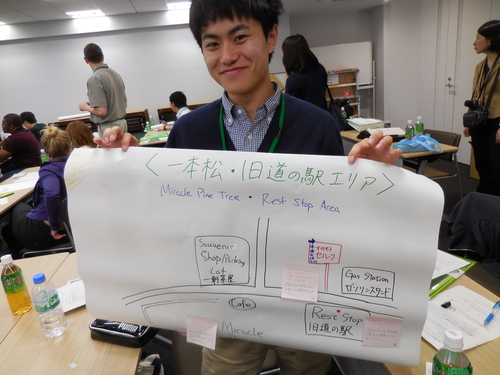Postcards Home from Japan: Day Two, Part Two—working toward normalization
by Kathleen McCoy |

Students worked to find ways to improve accessibility in Rikuzentakata as it is being rebuilt from the 2011 earthquake and tsunami. (Photo courtesy of GEOG A490)
Written by Cole Murphy Studying Japanese, Philosophy and International Studies
Brief/Abstract: Five groups of University of Alaska Anchorage (UAA) and Iwate University (IU) students looked at five different areas of Rikuzentakata in a field survey effort to expand the conscious-considerate eye of the Rikuzentakata Normalization process. The examined locations include, in group-number order, the Community Hall and City Hall, the Ippon Matsu "Miracle Pine Tree" Memorial Area, Takekoma Station and the surrounding area, the Rikuzentakata (Temporary) Local Hospital, and the AEON Supermarket. City officials, camera crew(s), and a number of key local positions/persons were present to reflect with IU and UAA students and faculty following each presentation on the current successes and future goals of the Rikuzentakata Normalization Project.
Special thanks extended to these individuals and to the people of Rikuzentakata who welcomed us with abundant generosity and kindness.
Introduction/Normalization: For residents, normalization means that one can perform the same functions with little to no disadvantage or need for assistance. This, for instance, expands out to such groups as those who are blind and/or deaf, those with physical impairments or injuries, the elderly, individuals that are illiterate and/or cannot communicate in Japanese (or whatever primary language is used), and those with psychological and/or physiological difficulties/challenges in living in everyday society.
For city planners and local officials, normalization is (will be) achieved when normalization need no longer be mentioned - when it is not even given a second thought in the community consciousness. To them, normalization is an utterly important aspect of a successful city, so listening to our perspectives on normalization was, as shown through taking of notes and mention of reflections already in motion based on our presentation/work, a positive and in many aspects highly valuable use of everyone's time.
Preparation: Groups were sent throughout Rikuzentakata with the main purpose of finding at least 3 examples of where normalization could be implemented to improve the collective experience within the town. Groups had the secondary goal of reflecting on potential normalization challenges and solutions within their own understanding and experience. When came the time to present, groups gathered, busted out visual aid with provided markers and paper, and reflected with good pace.
Reflection: All groups performed the full scope of the project assignment within a 4-hour window. One of the largest challenges in this workshop was the language barrier between the UAA students speaking primarily English and the Iwate Students and Rikuzentakata officials speaking primarily Japanese. Our saving grace here, as anyone would agree, is the functioning level of English that literally each Iwate student possessed - these young, wonderful minds were pivotal to this project, this experience, this entire trip.
Many of us do not consider the challenges others may face in daily living, and this project helped to open our eyes collectively to the minds of considerate and hardworking city planners and authorities like the professionals we met in Rikuzentakata as well as those who face such challenges within society in Japan and throughout the world. We see now that things like having brail under signs is utterly important and necessary even if one person may use it on a given day - that all building must facilitate micro-transit with technologies like entry ramps and elevators and automated doorways. Through the remainder of our journey in Japan, we kept our eyes peeled for what has been done to promote/embody normalization and where improvements could be made from our perspective as native English speakers and foreigners. These such lessons can be easily applied to where we live - to our university - and as teachers and pupils; sensei and seito, we know that this workshop was among our richest academic and reflective experiences in Rikuzentakata and in Japan as a whole.
On behalf of UAA, I extend immense appreciation to the Iwate students and faculty, and to the officials of Rikuzentakata whom served as our guides in a place that will remain in the hearts and minds of people across the world for a very long time. Congratulations to everyone for the progress made - we all know that it is an ongoing and hard-fought effort. Thank you for your abundant care and consideration - we all strive to become professionals and persons much like yourselves.
Rikuzentakata, Ganbappeshi! 陸前高田、がんばっぺし!
Cole Murphy
Hello! I'm a sophomore at the University of Alaska Anchorage majoring in Japanese, International Studies, and Philosophy. At UAA I enjoy getting involved as a member of the Japanese Culture Club and president of the Meditation and Wellness Club while working part-time for the UAA Honors College.
Living as a full-time student has been a really great experience for me these past two years for a great number of reasons, including the amazing people, fun opportunities and contests, and powerful lessons and wisdom I've encountered at UAA. I am really excited to experience being immersed by so many of my close interests in Japanese culture! Nice to meet you!
Cole Murphy was one of 10 UAA students to travel to Japan this summer as part of geography class bringing home to Alaska lessons the Japanese have learned from surviving earthquakes and tsunamis. Read more Postcards Home from Japan.
 "Postcards Home from Japan: Day Two, Part Two—working toward normalization" is licensed under a Creative Commons Attribution-NonCommercial 4.0 International License.
"Postcards Home from Japan: Day Two, Part Two—working toward normalization" is licensed under a Creative Commons Attribution-NonCommercial 4.0 International License.















